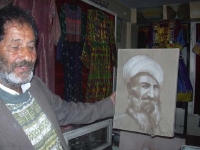Rabanni Rangbean, artist
Street address: Karte Char District, Kabul (contactable c/o CHA Gallery of Fine Arts and Traditional Afghan Crafts)
 Artist Rabanni Rangbean lives in Karte Char, sharing two rooms with 12 people for 1,500 Afghans (US$30) a month. He works at CHA Gallery, who provide him with wood and a studio in which he can work, and they pay him $60 per month for the sculptures he makes. Artist Rabanni Rangbean lives in Karte Char, sharing two rooms with 12 people for 1,500 Afghans (US$30) a month. He works at CHA Gallery, who provide him with wood and a studio in which he can work, and they pay him $60 per month for the sculptures he makes.Rabanni studied with German artist Alfred Knight from 1958 to 1961 at the Fine Arts College, predecessor of the Afghan Traditional Arts Training School - Ghulam Mohammad Maimanagi. During that period the materials and tools used at the school came from Germany and were of the highest quality. Today Rabanni works with tools given to him by a professional carpenter.
After three years studying sculpture and painting, Rabanni went to China for further training. The professors in China were surprised at the excellent skills of this Afghan. Yet when he returned from China the government of Afghanistan wasn’t looking for sculptors, so he then studied painting with the famous artist Abdul Ghafur Breshna, composer of Afghanistan’s national anthem. At this time Rabanni made money from selling paintings and teaching at the college. He remembers that one of his best students went to Holland to study and wrote to him: ‘whatever I know about art, all the common people in Holland know.’ Rabanni knew many artists who went to study in Russia. They became excellent academic artists, but in his view to be a real artist ‘you need to be a bit crazy because art comes from the heart.’ Rabanni lived through many unsettled times but if his muse was not with him he wasn’t able to produce any works.
Rabanni was later commissioned to draw the art for school textbooks and received a scholarship from the Americans to study in Iran. He remembers his teacher at that time saying ‘an artist must be himself, he shouldn’t copy anyone else.’
The first students in the western arts of watercolour and oil painting during the 1940s were trained to copy the great paintings, but their German professors reminded them that they must always acknowledge who they copied from. ‘Now’ says Rabanni ‘painters copy and write their own name against their work. They have no idea of composition or design.’ Rabanni claims to be one of the few Afghan artists who paints or sculpts from his own ideas. He believes the fact that so many artists copy is understandable, since a poor artist can paint a famous scene and receive money from tourists. ‘The tried and true puts food in your stomach’. Rabbani works in wood, plaster of paris and marble. His latest piece of walnut sculpture measuring one metre by 80 centimetres was of two Buzkashi horsemen. It took him six months to complete and he received US$360 from CHA Gallery. It now sits in the gallery with a price tag of US$1,000. He sold one of his first paintings to the German Ambassador in 1962 for 400 Afghans (at the time about US$11). In the 1960s and 1970s many tourists visited his art gallery, especially Germans and Americans, but he didn’t want to sell his sculptures, only his watercolours and oil paintings. After the Russians came he was forced to move all around the city and pieces were lost or given to neighbours as gifts. Then he moved to Pakistan where he made small pieces from marble or lapis lazuli which were bought by shops catering to the tourist trade. At this time Rabbani sold all his paintings, about 500 in all, to an Afghan art dealer in Pakistan who sold them to tourists. This dealer has just returned to open a shop on Chicken Street, and still has many of Rabanni’s old paintings left. ‘This man was the only one to buy my work so I could make money from my art.’
It’s easy to find walnut wood in Afghanistan and Rabanni’s hope is to be able to buy some wood for himself and find a small studio where he will be independent and can practice his skill creatively. He has spent too many years making art to eat. ‘Students in the west have better daily conditions so they are able to work from their heart. They can make a lot of progress in art because they have time to practice and experiment. When you read the biographies of the great Russian painters you realise how hard they worked as students to be able to create masterpieces in their later life. On the other hand, Van Gogh said, ‘an artist must have the capacity of a buffalo to work hard’. And that Rabanni has.
|
|
||||||

You are here: Welcome to the Afghanistan Cultural Profile > Culture in Afghanistan > Visual arts > Modern and contemporary visual arts > Rabanni Rangbean, artist
| ||||||


|
||||||
|
|
 |
created with financial support from
Date updated: 18 August 2004
|
||||
The website is powered by a Content Management System developed by Visiting Arts and UK software company Librios Ltd http://www.librios.com

